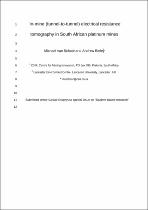 ResearchSpace
ResearchSpace
In-mine (tunnel-to-tunnel) electrical resistance tomography in South African platinum mines
JavaScript is disabled for your browser. Some features of this site may not work without it.
- ResearchSpace
- →
- Research Publications/Outputs
- →
- Journal Articles
- →
- View Item
| dc.contributor.author |
Van Schoor, Michael

|
|
| dc.contributor.author |
Binley, A

|
|
| dc.date.accessioned | 2011-05-12T07:17:10Z | |
| dc.date.available | 2011-05-12T07:17:10Z | |
| dc.date.issued | 2009-12 | |
| dc.identifier.citation | Van Schoor, M. and Binley, A. 2010. In-mine (tunnel-to-tunnel) electrical resistance tomography in South African platinum mines. Near Surface Geophysics, Vol. 8(6), pp 563-574 | en_US |
| dc.identifier.issn | 1873-0604 | |
| dc.identifier.uri | http://hdl.handle.net/10204/5000 | |
| dc.description | Copyright: 2010 European Association of Geoscientists and Engineers (EAGE) | en_US |
| dc.description.abstract | The applicability of tunnel-to-tunnel electrical resistance tomography (ERT) for imaging disruptive geological structures ahead of mining, in an igneous platinum mining environment is assessed. The geophysical targets of interest are slump structures or ‘potholes’ that disrupt the lateral continuity of the thin, tabular platinum orebodies of the Bushveld Complex, South Africa. The study involves a combination of model studies, laboratory property measurements and trial surveys. The property studies indicate that the problem reduces to the challenging scenario of a high-resistivity background (orebody horizon) in which an even more resistive target (pothole) is embedded. The model studies show that ERT can potentially image disruptive potholes ahead of mining. It is further demonstrated that the 2D approach can generally be used as a reconnaissance tool, but that a variety of three-dimensional (3D) effects need to be considered, and, in some instances, appropriate corrections should be applied. 3D scenarios that are considered include targets with limited extent perpendicular to the image plane, targets with a relatively small volume and targets that are asymmetrical about the image plane. Other 2D model assumption violations considered include the effect of tunnels and multi-layered backgrounds. Finally, results from an experimental in-mine survey are included to illustrate that ERT can be used to detect and delineate potholes ahead of mining | en_US |
| dc.language.iso | en | en_US |
| dc.publisher | European Association of Geoscientists & Engineers (EAGE) | en_US |
| dc.relation.ispartofseries | Workflow request;5707 | |
| dc.subject | Tomography | en_US |
| dc.subject | Electrical resistance tomography | en_US |
| dc.subject | Geological structures imaging | en_US |
| dc.subject | Potholes | en_US |
| dc.subject | Bushveld complex | en_US |
| dc.subject | Platinum mines | en_US |
| dc.subject | Tunnels | en_US |
| dc.subject | 3D effects | en_US |
| dc.subject | Geology | en_US |
| dc.subject | Mining | en_US |
| dc.subject | Geophysics | en_US |
| dc.title | In-mine (tunnel-to-tunnel) electrical resistance tomography in South African platinum mines | en_US |
| dc.type | Article | en_US |
| dc.identifier.apacitation | Van Schoor, A. M., & Binley, A. (2009). In-mine (tunnel-to-tunnel) electrical resistance tomography in South African platinum mines. http://hdl.handle.net/10204/5000 | en_ZA |
| dc.identifier.chicagocitation | Van Schoor, Abraham M, and A Binley "In-mine (tunnel-to-tunnel) electrical resistance tomography in South African platinum mines." (2009) http://hdl.handle.net/10204/5000 | en_ZA |
| dc.identifier.vancouvercitation | Van Schoor AM, Binley A. In-mine (tunnel-to-tunnel) electrical resistance tomography in South African platinum mines. 2009; http://hdl.handle.net/10204/5000. | en_ZA |
| dc.identifier.ris | TY - Article AU - Van Schoor, Abraham M AU - Binley, A AB - The applicability of tunnel-to-tunnel electrical resistance tomography (ERT) for imaging disruptive geological structures ahead of mining, in an igneous platinum mining environment is assessed. The geophysical targets of interest are slump structures or ‘potholes’ that disrupt the lateral continuity of the thin, tabular platinum orebodies of the Bushveld Complex, South Africa. The study involves a combination of model studies, laboratory property measurements and trial surveys. The property studies indicate that the problem reduces to the challenging scenario of a high-resistivity background (orebody horizon) in which an even more resistive target (pothole) is embedded. The model studies show that ERT can potentially image disruptive potholes ahead of mining. It is further demonstrated that the 2D approach can generally be used as a reconnaissance tool, but that a variety of three-dimensional (3D) effects need to be considered, and, in some instances, appropriate corrections should be applied. 3D scenarios that are considered include targets with limited extent perpendicular to the image plane, targets with a relatively small volume and targets that are asymmetrical about the image plane. Other 2D model assumption violations considered include the effect of tunnels and multi-layered backgrounds. Finally, results from an experimental in-mine survey are included to illustrate that ERT can be used to detect and delineate potholes ahead of mining DA - 2009-12 DB - ResearchSpace DP - CSIR KW - Tomography KW - Electrical resistance tomography KW - Geological structures imaging KW - Potholes KW - Bushveld complex KW - Platinum mines KW - Tunnels KW - 3D effects KW - Geology KW - Mining KW - Geophysics LK - https://researchspace.csir.co.za PY - 2009 SM - 1873-0604 T1 - In-mine (tunnel-to-tunnel) electrical resistance tomography in South African platinum mines TI - In-mine (tunnel-to-tunnel) electrical resistance tomography in South African platinum mines UR - http://hdl.handle.net/10204/5000 ER - | en_ZA |





